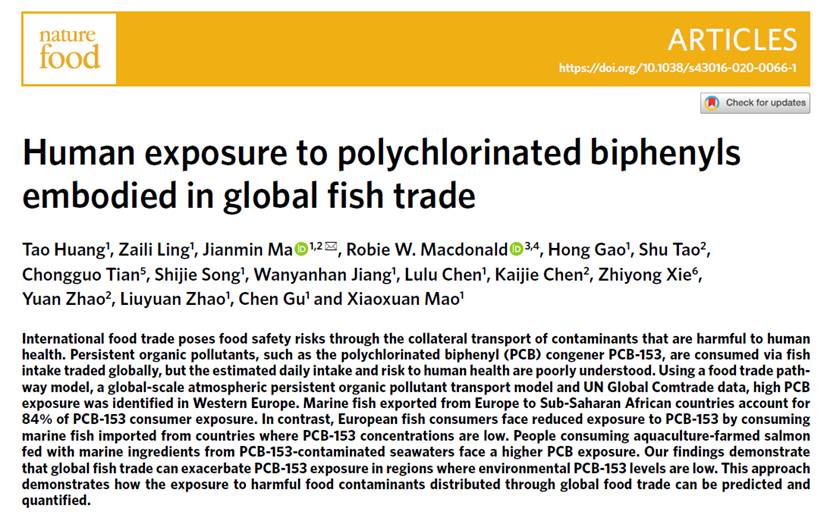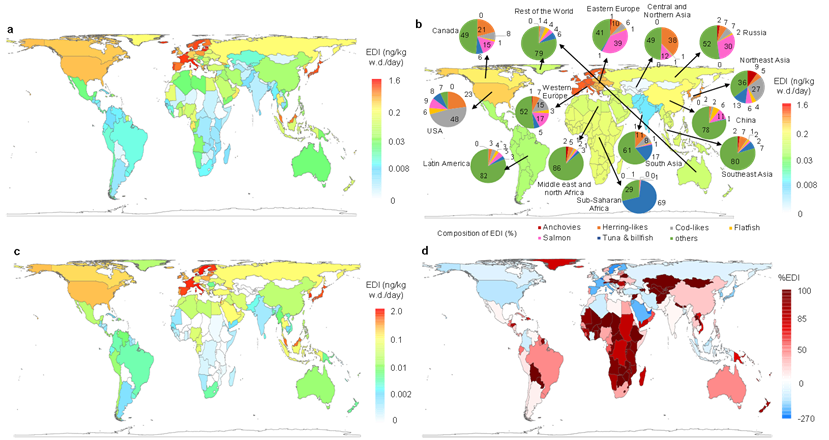
Recently, researchers from the Key Laboratory for Environmental Pollution Prediction and Control and the college of Earth and Environmental Sciences, Lanzhou University, revealed the shifting risk of human exposure to polychlorinated biphenyls (PCB) embodied in the global fish trade. For the first time at home and abroad, the study simulated and evaluated the environment of toxic pollutants and the pollution level of exported food from the source and place of production, realizing large-scale food safety assessment on a global scale, and providing a new idea and method for the global and regional food safety and risk assessment of imported and exported food.
In today's globalization and economic integration, the rapid growth of global and regional (national) food trade and logistics has increasingly enriched the food on people's table but brought increasing pressure and new challenges to food safety and testing. The traditional small sample, random sampling, and laboratory analysis used in food safety inspection for import and export have not been able to adapt to the rapid development of food trade at home and abroad.
The research results suggest thatin Northern Europe, the United States and Northeast Asia, due to the historically high PCB emissions, the coastal PCB pollution is seriousand the concentration of PCB in Marine fish is significantly higher than that in other regions.These countries import less contaminated Marine fish from other countries, resulting in a decrease in PCB exposure among their residents.In contrast, other regions import more polluted Marine fish from these regions, leading to increased PCB exposure among their residents.In particular, Western Europe, historically the largest producer of PCBs, account for 84% of PCB exposure among adults in Africa, 73% in eastern Europe, and 48% in Central Asia.The results also partly answer a question that has puzzled researchers: PCB concentrations in African women's milk are unusually high, despite the low levels in the environment. The cause may have been the consumption of PCB-contaminated Marine fish imported from Europe.The study also found that 61% of PCB exposure among Chinese adult Marine fish consumers came from Marine fish caught in their waters, 39% from imported Marine fish, and 20% from Western Europe, which has the worst PCB contamination.

Figure 1.Daily PCB intake per person in each country considering and not considering global Marine fish trade (EDI, estimated daily intake, ng/kg b.w./d).(a) National EDIin the context of Trade;(b) The contribution of regional EDI and various Marine fish in the context of Trade;(c) National EDI in the context of No Trade;(d) Contribution of Marine fish trade to National EDI.

Figure 2. Net outflow of PCB EDI from each country caused by global Marine fish trade (a) and EDI transmission channel implicit in Marine fish trade (b)
For a long time, one of the research hotspots on the risk of toxic pollutant ingestion mainly lied on how the human food webs travel long distances across borders (regions) and settle into the recipient regions after they are discharged into the atmosphere and Marine environment by human activities.Little attention has been paid to the diversion of pollutants and the risk of human exposure from food trade.The team's study points out that food trade provides another route for the movement of toxic pollutants between countries or regions. Unlike long-distance transport through the atmosphere and oceans, the transport of toxic pollutants caused by food trade is from the production side to the consumption side.The trade flow of contaminated food from production to consumption is a more direct and efficient route than air and sea transport.
The study named by " Human exposure to polychlorinated biphenyls embodied in global fish trade" was published online on May 11 in the journal Nature Food. Associate Professor Huang Tao from the college of Earth and Environmental Sciences, Lanzhou University is the first author, and corresponding author is Professor Ma Jianmin. Nature Foodinvited Professor Derek Muir, a member of the Royal Canadian Academy of Sciences, to write a review of the paper entitled "Toxic Chemical Exposure from Global Fish Trade", which was published in the same issue. The research was funded by the National Key Research and Development Program, the National Natural Science Foundation of China.